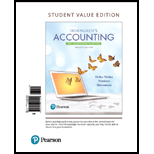
Concept explainers
Introduction:
Capital Rationing: Capital Rationing is the process of allocation of amount to be invested in the project. Capital Rationing is done using the methods of capital budgeting. Some of those methods as are as follows:
Payback Period: Payback period is the period in which the project recovers its initial cost of the investment. It can be calculated by dividing the initial investment by the annual
Hence, smaller the payback period better it is. A project with the smaller payback period is chosen first in the capital rationing process.
ARR: Accounting
The formula to calculate ARR is as follows:
Hence, higher the ARR better it is. A project with the Higher ARR is chosen first in the capital rationing process.
NPV:
A project should be accepted if it has a positive NPV. Hence, higher the NPV better it is. A project with the Higher NPV is chosen first in the capital rationing process.
To Choose: The true statements about the capital rationing decisions
Want to see the full answer?
Check out a sample textbook solution
Chapter 26 Solutions
Horngren's Accounting: The Managerial Chapters, Student Value Edition (12th Edition)
- Please give me answer with general accounting questionarrow_forwardStock 1 has a beta of 1.97 while stock 2 has a beta of 0.76. The current risk-free rate is 3% and you determine the expected return on market to be 9%. Your portfolio will consist of 40% of stock 1 and 60% of stock 2. What is the required return for Stock 2?arrow_forwardCraig Goods is analyzing its break-even point for a product with a selling price of $75 per unit. The variable cost per unit is $50, and the fixed costs are $180,000 per year. If the company wants to achieve a profit of $60,000, how many units must it sell to meet this profit goal?arrow_forward
- FeatherSky Ltd. has a balance sheet equity of $7.1 million. At the same time, the income statement shows a net income of $1,120,000. The company has 175,000 shares of stock outstanding. If the benchmark PE ratio is 25, what is the target stock price in one year? Helparrow_forwardThe total of the period costs?arrow_forwardWhat are the cash payments FedEx made for interest and for income taxes in the three years reported, 2020, 2019, and 2018? (Hint: See the disclosure notes.)arrow_forward
- General accountingarrow_forwardWhat is the division's turnover of this financial accounting question?arrow_forwardDakota Manufacturing uses a job costing system. The work in process inventory on November 30 consisted of Job No. 251 with a balance of $72,800. Job No. 251 has been charged with manufacturing overhead costs of $22,500. Dakota allocates manufacturing overhead costs at a rate of 60% of direct labor cost. What was the amount of direct materials charged to Job No. 251?arrow_forward

 AccountingAccountingISBN:9781337272094Author:WARREN, Carl S., Reeve, James M., Duchac, Jonathan E.Publisher:Cengage Learning,
AccountingAccountingISBN:9781337272094Author:WARREN, Carl S., Reeve, James M., Duchac, Jonathan E.Publisher:Cengage Learning, Accounting Information SystemsAccountingISBN:9781337619202Author:Hall, James A.Publisher:Cengage Learning,
Accounting Information SystemsAccountingISBN:9781337619202Author:Hall, James A.Publisher:Cengage Learning, Horngren's Cost Accounting: A Managerial Emphasis...AccountingISBN:9780134475585Author:Srikant M. Datar, Madhav V. RajanPublisher:PEARSON
Horngren's Cost Accounting: A Managerial Emphasis...AccountingISBN:9780134475585Author:Srikant M. Datar, Madhav V. RajanPublisher:PEARSON Intermediate AccountingAccountingISBN:9781259722660Author:J. David Spiceland, Mark W. Nelson, Wayne M ThomasPublisher:McGraw-Hill Education
Intermediate AccountingAccountingISBN:9781259722660Author:J. David Spiceland, Mark W. Nelson, Wayne M ThomasPublisher:McGraw-Hill Education Financial and Managerial AccountingAccountingISBN:9781259726705Author:John J Wild, Ken W. Shaw, Barbara Chiappetta Fundamental Accounting PrinciplesPublisher:McGraw-Hill Education
Financial and Managerial AccountingAccountingISBN:9781259726705Author:John J Wild, Ken W. Shaw, Barbara Chiappetta Fundamental Accounting PrinciplesPublisher:McGraw-Hill Education





